Extremely Puzzling - Goetz Schwandtner's Puzzles
Feature Page: Game Craze
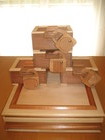
|
Some months ago I saw pictures of some nice puzzle boxes show up on facebook from a designer I did not know: Tracy "Wood" Clemons, the "Green eyed Lady". These boxes looked interesting and beautifully made and received very positive comments, so when I had the chance, I contacted Tracey and we started discussing a new puzzle box project. It should be a custom puzzle box for me, and so we launched a discussion what a possible theme might be. Soon I had an idea: I love board games and puzzles, so why not make it a board game puzzle box? Tracy liked this idea and we chatted about some details. Then she started designing and working on the design and the result is the puzzle displayed on this page: Game Craze. A big Thank You to Tracy for this wonderful puzzle!
|

|
A beautiful puzzle, but what is it actually? Let's take a closer look!
The puzzle is beautifully made, well crafted, and I already love it! It is the biggest puzzle in my collection so far, which might also be due to the fact that it is not only one box, but consists of one big, flat box, and four smaller boxes with wooden padlocks. Of course these are not usual padlocks, but small puzzles by themselves. Now it is a puzzle consisting of several boxes and locks, so how does it fit into the categories on my page? Not into a single category, I am afraid! Let's give it a try:
- Puzzle Box: That is the obvious choice with five boxes, isn't it?
- Puzzle Lock: There are four of them!
- Assembly Puzzle: There are pieces inside not yet shown and you have to assemble them.
- Sequential Discovery: There are tools involved, and you have to find some pieces before you can continue to go for the big solution.
- Game: Part of the name of the puzzle, and in fact is also a board game for up to four players!
|
.JPG)
|
Wait! A Puzzle Board Game?
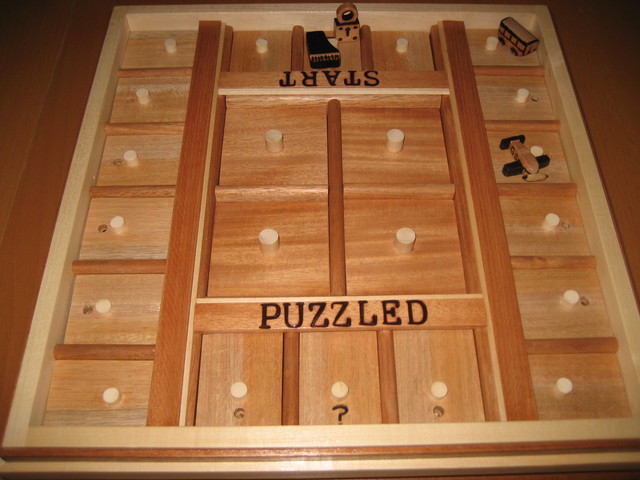
|
Opening the lid of the big box is easy, no tricks involved. Once you have opened it, you see a strange arrangement of squares and rectangles, which might remind you of some board game arrangements. And that is exactly what it is: A board game board. The players start in the field labelled "Start", roll a die, and move on the fields along the edges of the box. A board game!
As you might have guessed, these are not only board game fields, but also little compartments with lids on them. Each field can be opened up when the player's playing figure is moved onto that field. Well, some of them are locked and need to be opened with some tools provided with the puzzle. A board game and a puzzle combined! In these little compartments, pieces of some assembly puzzles can be found. The goal of each player is to collect his pieces and build a tower before everyone else.
|
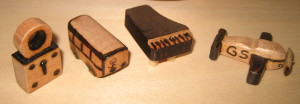
|
In the picture to the left you can see the details of the playing figuers. They are: A piano, a bus, a plane, and a (puzzle) padlock. Don't they look cute? And notice all the little details! The plane has even my initials engraved!
So far you might have been wondering what these four other boxes do. Well, they are part of the puzzle and part of the game, and they come into play when all the playing fields of the main board have been opened. There is usually one box per player, but what do they do?
|
Four more puzzle boxes
Before we have a look at the boxes, we should have a short look into the playing rules to understand what happens. For a clearer illustration, I have opened all the doors of the playing field and taken a picture. The rules are roughly:
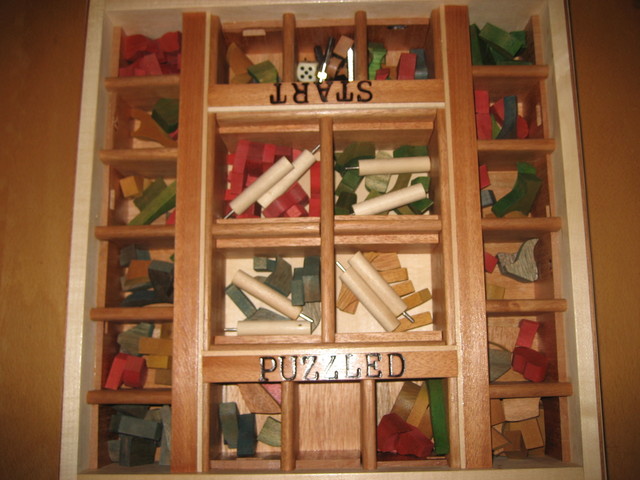
|
- Player rolls a die and moves the number of fields.
- If the player hits a corner for the first time, he/she opens that door and the door next to it in the center. The player will now play with the colour of the pieces in these two compartments.
- If the player hits a non-corner field and already has a colour, he/she tries to open it and takes out the tower pieces. Without having hit a corner before, the player will leave the door closed.
- If the player hits the "Puzzled" field, he/she will have to pass next round and the little playing figure is put behind that door for waiting.
- If several players have tower pieces, they may trade with others in their own turn.
The last option with trading is vital. As you can see, the non-corner fields contain pieces of several colours, and the player opening that field does not have any use for the other colours, other than trading them for the own colour. The goal is to build a tower with all pieces of the own colour, so trading seems useful here.
|
Now how about those boxes again?! Those with the padlocks!
Well, there is a picture of them opened to the right. More tower pieces, and nicely sorted by colour, so each player should get one — right?
That is exactly what happens. When you hit the first corner piece with your playing figure, you do not only get the tower pieces and the stuff from the adjacent center compartment (like two lock-picks), but also the box with the same mark on the bottom. Keep the lid from the box you will need it!
Unfortunately, at that point you have to put the boxes aside and keep on playing — not a bad choice either! And in case you are more curious to get those boxes open, maybe this motivates you to engage in the game, too!
|

|
Trying to Unlock Your Materials and the Base of Your Tower
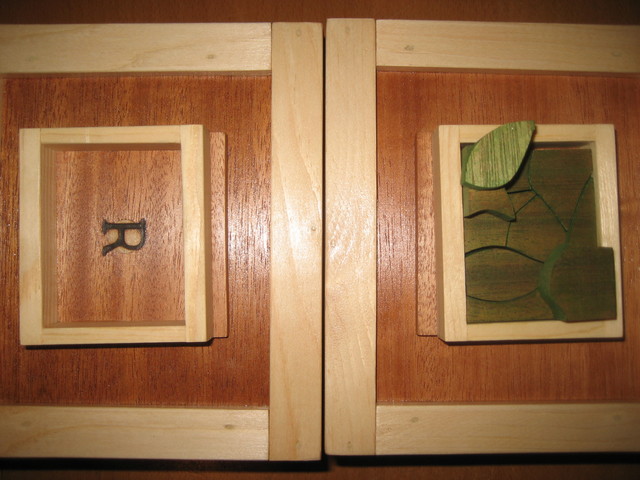
|
Only when all players have received all tower pieces of their colour, when the last trade has finished, all players are allowed to start lock picking: Open the lock with the two wooden lock picks, of which each player received two, open the box, get the tower pieces out and prepare the box as a nice base for the tower. By removing the small ornament in the middle of the box lid, you can put the lid of the center compartment on your box upside down. Within the inside of this rectangle you will have to lay the base of your tower.
In the picture to the right you see the base of the red tower (labelled with "R" and with no pieces yet) and the green tower as example. The first layer of the green tower has been laid out and from the picture you will get an idea how the pieces might look like. There are also pieces going over several layers, like the two layer piece and three layer piece in the picture. The red tower has even got four layer pieces. These pieces do not only ensure uniqueness of the solution of the whole tower, but can also provide you some hints about the next layers.
With all these pieces, it might get pretty crowded with four players building towers and laying out pieces for them. The game board box can be put aside, and there might even be some now empty boxes to store the locks, ornaments and lock picks in!
|
The Towering Inferno
The towers are undoubtedly the most difficult part of the whole puzzle game. I have not counted the pieces involved, but can give you some other numbers to estimate. Each tower consists of 10 layers of pieces when finished. Each layer may have between 7 and 12 pieces, depending on tower and layer. Assembling the towers may take quite some time, especially if you are not very good at assembly puzzles, like myself.
However, there are some things which may help you to defeat that "towering inferno":
- The pieces you found in the corner compartment of the big box are exactly the ones for the bottom layer to start with.
- The pieces from the center compartment are for layer 4, the ones spread over the compartments of the board, are for layers 2 and 3. That leaves you with a good starting position, but there are 6 more layers in the box with the padlock.
- Pieces do not only have many different shapes, but they are made of wood and you can see from the wood grain in which orientation to place them.
- Different layers are built from different woods, or different widths of wood boards. That makes it easier to match them together before building the layers. However, on some layers wood grain and board widths are the same — we don't want it to be too easy, do we?
In the picture to the right, you can see the four towers assembled completely.
|

|
The towers have different difficulty (based on my experience when solving). Yellow is the easiest, then followed by green. Blue is the most difficult, directly followed by red, which is only slightly easier. However, this may depend on each puzzler's personal skills and preference, and for this reason you cannot pick a tower, but the colour is randomly assigned to you by the rolls of the die during the game (as described above).
If you have followed my description of game rules closely, you might be asking yourself, if the order in which the players finished the board game part of the game has any impact on the tower building part, or not. It was mentioned above that you may only open the padlock box after all players have their pieces, so they would all start at the same time? Well, players may actually start building before that with the pieces they already have. Therefore it will always be possible to complete the base layer, maye a bit more even. Of course this should not stop the board game from going on: When the player before you has finished the move, you must stop working on the tower and roll the die and perform your move. Unless you have stepped on the "Puzzled" field. Then you also have to stop working on your tower until you leave that field again. Bad luck!
The rule that all players try to open their padlock at the same time improves the game: On one hand, you do not have some players moving around the board while others are completing their tower already, and on the other hand, it reduced the luck introduced by the die a bit, which makes it more a game of skill than only luck. Of course, with the die moves, the random selection of player colours, and the distribution of the pieces over the game board field, there is enough luck left.
Puzzling Parts

|
Now finally some words about the padlocks and the other puzzle components. In the picture to the left you can see the tools and pad locks involved in this puzzle game. The locks have all different locking mechanisms, based on a similar principle and all spring-loaded. They can be opened with the two lock picks each player receives and have different difficulty level. They also have all a magnet to keep the cover shut. Very nice details of the puzzle!
Beside the locks you can see two other tools, which are to be used when opening doors in the game field. These doors have either no lock, or one of three different basic types of locks. Depending on the locking mechanism of the field, you will need either one or the other unlocking tool.
Both the padlocks and the locks in the game board are not overly complicated, but they offer a nice challenge. Remember that all this is part of one game to be played by several players, and that also limits the time available for individual puzzle elements.
In my opinion, the locks and padlocks have the right complexity for a puzzle game. The towers should also be at a good difficulty level considering the types of players who would play such a game.
|
I do not have any experience about playing times with this puzzle game in a real situation with several players yet, but from my experience with all the parts of the puzzle I would guess it can be played within the time of a longer board game. Of course it all depends on the skills of the players present. If they do not have any experience with assembly puzzles, it might take much longer to build the towers.
Puzzle Game or Game Puzzle?
Game Craze is a beautiful and well crafted collection of boxes, but has many more details to offer. Over the time of playing with the puzzle / game, I enjoyed finding little details included in it, and different aspects. After being curious to see what is behind all those doors, I also had some Aha! moments when building the towers. It is fascinating that pieces suddenly match after they did not seem to make any sense before. I had an excellent time playing with the puzzle and am looking forward to testing this puzzle / game on some puzzlers / gamers. So what it is? A puzzle or a game? Well, it is both, and the aspects cannot be separated completely. This is also fascinating about this puzzle / game. At the moment, I am not aware anything similar exists in the game or puzzle world, but maybe we will see some other puzzle / game in the future.
Thank you, Tracy, for designing and building it for me!